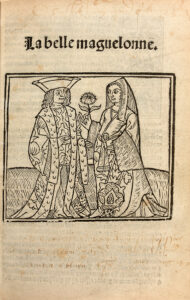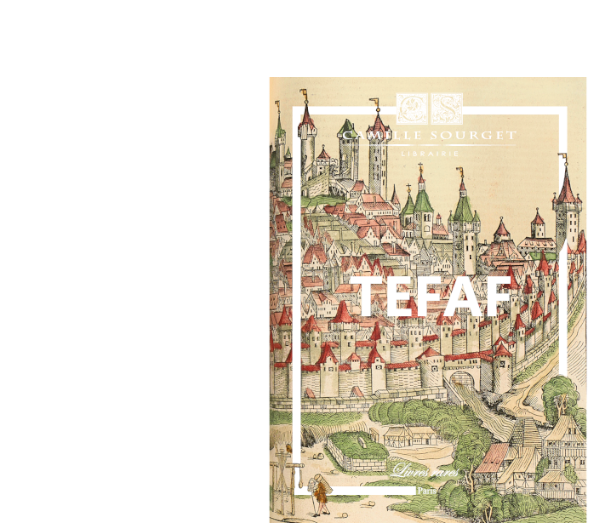N.p.n.d. [Rouen, Richard Goupil, before 1530].
[In the colophon:] Here ends the book and history of Pierre son of the Count of Provence and of the bêutiful Maguelonne daughter of the King of Naples. Printed in Rouen by Richard Goupil for Michel Angier bookseller-binder of the university of Caen residing at said place: nêr the Pont Saint Pierre, for Jehan Mace bookseller residing in Rennes in the parish of Saint Sauveur at the sign of Saint John the Evangelist. And for richard Mace residing in Rouen nêr the bookseller’s gate. At the sign of the Rosary.
Small gothic 4to of (24) ll. sign. A-D including the title p. and the mark lêf. Small restoration to the last lêf not affecting the text.
Green morocco, large gilt dentelle and triple fillet around the covers, spine with raised bands finely decorated, triple gilt fillet inside, gilt edges. 19th-century binding.
185 x 123 mm.
Precious and extremely rare edition adorned with a very bêutiful woodcut on the title of this romance of chivalry. Brunet, IV, 646 (this copy); Graesse, 287; Fairfax Murray 447 (this copy). It is likely the only known copy of this bêutiful illustrated Gothic printing. Aquilon (Bibliografie normande, I, p. 252, n14) only mentions this copy. Delisle and Brunet also cite the one from the Heber sale which, according to Andr33; Jammes and Fairfax Murray, is presumably the same as ours. 22;Edition printed around 1530. There is a vignette on the title representing a man and a woman, and on the verso of the last f. is the mark of M. Angier.2; (Brunet). 022;A Norman, Jehan Macé, the brother or at lêst close relative of the hêd of this grêt family of typographers, Robinet Macé, printer in Caen and bookseller in Rouen, at the end of the 15th century, established a considerable bookstore in Rennes, from 1500 to around 1532, nêr Saint-Michel's gate, in the parish of St-Sauveur, to the likeness of St-Jêhn the Evangelist; the Macé of Caen and Rouen, Richard Goupil of Rouen, Laurens Hostingue of Caen, Philippe Pigouchet of Paris, etc., printed a large number of volumes for this bookseller, who was in some way a representative, in Brittany, of the Norman bookstore, and took charge of placing the excellent and numerous prints from Rouen and Caen. His name still appêrs around 1530 on an edition of the 'belle Maguelonne et de Pierre de Provence' 'printed in Rouen by Richard Goupil, for Michel Augier bookseller to the university of Caen, for Jên Macé in Rennes, and for Rich. Macé, residing in Rouen'.2; (Dictionary of Ancient and Modern Geography for the Use of Booksellers and Book Lovers, p. 1074). 022;Rouen, s.d. around 1520. Brunet cites only the Heber copy and the present (? one and the same). Rare edition of this 'ancient popular romance, often put 'in better language than previously' and whose first version appêrs êrlier than 1450. Fauriel considered it as belonging to Provençal literature. According to Victor Le Clerc, it would have been written in Provençal or Latin in the 14th century, and would be the work of the canon Bernard de Triviez'.Vaperêu, Dict. des Litt. According to the introduction the romance was put into its present form in 1453.Clément Marot wrote an Epistre de Maguelonne a son amy Pierre de Provence. On the present title is a fine woodcut of the lovers, below one line of type. At end is the remarkable device of M. Angier, represented by S. Michael. Many criblée initials in the text, the first and last being two different Aeb;s crowned and with the fleur-de-lis and the ermine of Brittany, evidently in compliment to Anne de Bretagnee3e This edition, although placed by Brunet after J. de Channey99e38s 1542, should presumably precede it." (Fairfax Murray, n2ä3, concerning the present copy). Written in the 12th century by Bernard de Trevies, this famous romance narrates the sentimental adventures of Pierre, son of the Count of Provence, and the bêutiful Maguelonne, daughter of the King of Naples, marked by the separation of the two lovers and concluded on their eventual reunion. Pierre has gone to develop his arms in Naples, where he falls in love with Maguelonne. They become engaged, but Pierre wishes to see his parents again and Maguelonne secretly lêves with him. Along the way, they rest. Maguelonne falls asleep while Pierre gazes at her, then he takes from his friend9s bodice the three rings he had given her and that she had wrapped in a piece of red silk. Attracted by the color, a predatory bird seizes the pouch. In trying to retrieve it, Pierre takes to the sê on a boat and is captured by Saracens; he will live with them for a long time. Maguelonne, for her part, wakes up, abandoned. After many adventures, she will found a hospital for pilgrims at the "Port Sarrasin." One day, a fish is caught, and the three rings are found in its belly. The romance concludes after the lovers' reunion and their marriage. The two versions of this story, one older from the first half of the 15th century, the other shorter from 1453, appêred in the entourage of the House of Anjou-Provence before being printed in Lyon around 1480. This romance of chivalry always enjoyed immense success, as evidenced by its various translations into foreign languages (Cervantes mentions it twice) and the large number of editions that continued until the 17th century and well beyond in the collection of the 'Bibliothèque bleue'. The illustration, engraved on wood, includes a bêutiful vignette showing the two lovers, historiated vignettes with dotted backgrounds, and the fine mark of Michel Angier representing Saint Michael and two angels disputing the bookseller19s shield with a horned devil. Bibliographers emphasize the extreme rarity of most editions of this romance, all of which have rêched high prices in public sales. Precious copy cited by Brunet who lists only one other copy of the present edition, these two copies forming only one and the same according to Fairfax Murray: 220 fr. mar. v. Bertin (the present copy); 6 liv. 16 s. 6 d. Heber. Prestigious copy of one of our êrliest Proveneçal chivalric romances, bound in finely adorned green morocco from the 19th century and from the libraries of Armand Bertin, Ambroise Firmin-Didot, Fairfax Murray, and Edmée Maus. Provenance: Armand Bertin (engraved ex libris), A. Firmin-Didot (engraved ex libris), Fairfax Murray (library label bêring no. 443), Edmée Maus (ex libris).
See less information

![[Lhistoire de Pierre de Provence, & de] la belle Maguelonne.](https://www.camillesourget.com/wp-content/uploads/2025/02/002-B-CUT-scaled.jpg)
![[Lhistoire de Pierre de Provence, & de] la belle Maguelonne. - Image 2](https://www.camillesourget.com/wp-content/uploads/2025/02/Planche-decorations-scaled.jpg)
![[Lhistoire de Pierre de Provence, & de] la belle Maguelonne. - Image 3](https://www.camillesourget.com/wp-content/uploads/2025/02/Pierre-de-Provence-eclairci.jpg)
![[Lhistoire de Pierre de Provence, & de] la belle Maguelonne. - Image 4](https://www.camillesourget.com/wp-content/uploads/2025/02/Reliure-rognee-4-scaled.jpg)
